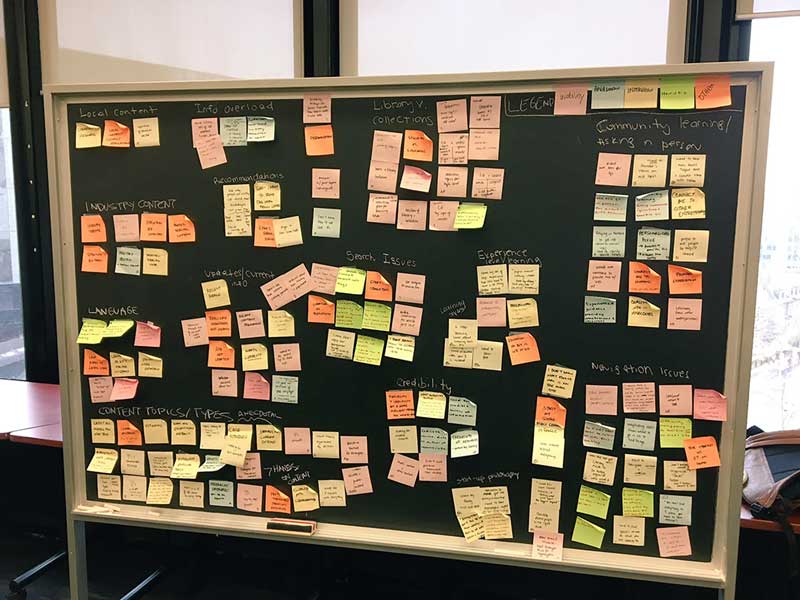Context
This year, I’m working on a Capstone project through the iSchool with two other UX students, Aditi Bhargava and Therese Owusu. The three of us are redesigning the MaRS Entrepreneur’s Toolkit. We’re sharing posts about our progress on our Medium blog, UX in the 6ix.

Problem
The purpose of the Toolkit is to support aspiring and early stage entrepreneurs in Ontario in launching and growing business ventures. MaRS decided to engage my team in a redesign to better leverage the high quality content the Toolkit currently provides.
We started our project with a user research phase which had four key goals:
- Usability: What current issues exist with the MaRS Entrepreneur’s Toolkit? What are current strengths of the MaRS Entrepreneur’s Toolkit?
- Context: What are users’ general attitudes towards online learning tools geared towards entrepreneurship?
- Workflow: What are some past experiences users have with searching for resources online? How do entrepreneurs actually work
- Opportunities: How could the online search process & resources be improved?
Process
Data collection

Heuristic evaluation: Each designer conducted a heuristic evaluation of the product to identify usability issues and compare our findings.
Usability testing: We ran usability tests on the toolkit with real users to identify usability issues and understand attitudes towards the product.
User interviews: We conducted user interviews to research entrepreneur’s attitudes towards and experiences with searching for resources. Interviews consisted of a Q&A and a show-and-tell activity.
Analogous inspiration: Analogous Inspiration is a method described in the IDEO Field Guide which involves designers immersing themselves in settings which resemble those of their users in order to better understand their experience. Each designer was assigned one or two analogous settings and provided with a scenario to research in that setting.
Research analysis sprint
To analyse all the data we collected, we held a one-day sprint to quickly and efficiently review all our findings and extract insights. I wrote a full overview of the sprint on Medium. Some key activities included:

Affinity mapping: With Beyoncé blasting in the background, we went through all our research and wrote down insights on post-it notes. We then looked for affinities among all our insights in order to articulate the key themes that emerged from our research.
Insight statements: Reviewing our themes, we discussed what we found and rephrased them into short sentences. This allowed us to transform themes into concise, actionable insights.
Problem statement matrix: For each persona developed, we created several problem statements. These allowed us to articulate our users’ problems related to our product.
User stories: We next took those problems and, at a high level, articulated how our product might solve those problems. We did so by creating user stories using a table with two columns: “User should be able to” and “so they can.”
Personas
We translated our users into three personas. View these personas in full size on xtensio: Molly, Hrishi, and Almeera.
Use cases, scenarios and preliminary requirements
I used our findings to create six use cases and three scenarios, corresponding to our personas.

I also created a set of preliminary requirements based on the features identified from our use cases and our user research.
Report & presentation
To conclude this phase of research, we created a comprehensive report and presented our summarized findings to our stakeholders.

Key Learnings
Interviews are a limited research method. In our user interviews, we combined the Q&A with activities because research indicates that users can’t often describe accurately how they actually do things. So interviews allowed us to explore users’ attitudes about online learning in entrepreneurship and discuss specific instances where they used online tools; while activities allow us to see how users actually work when confronted with a task and understand their mental models when attempting to fill an information need.
Turn to digital resources like Medium, agency blogs and more to mix up your methodology. We tried a lot of new activities thanks to resources from IDEO, Work Differently and more. We were even inspired to create a method of our own called “Themes Sheets”, which I wrote about on Medium, to allow us to map affinities among our research insights on-the-go.
Involve stakeholders through activities. To get our stakeholders excited about the project (and keep them excited throughout the research phase), we made sure to include activities in all our meetings to break up talk time and engage them actively in the research process. I wrote about one example of this on Medium when we used Product Definition Forms in our client kickoff meeting to look for affinities and discrepancies in the way different stakeholders view the product.
Other Medium posts I wrote about this project:
Using writing to get inspired in UX project planning
Next steps
This project is far from over as we move into the ideation and prototyping phase. In the next couple months, we’ll be using an Agile approach and engaging our users and stakeholders in co-design sessions to create a prototype and requirements set for the new MaRS Entrepreneur’s Toolkit. Follow along on Medium to watch our progress!


